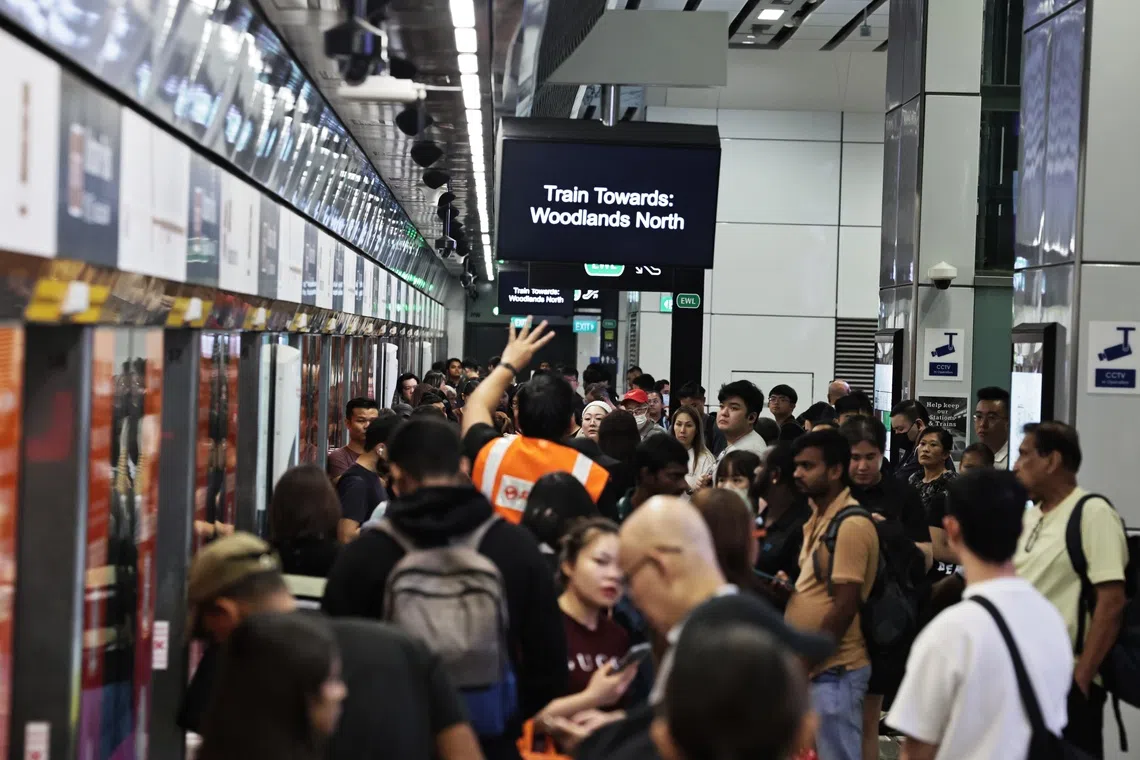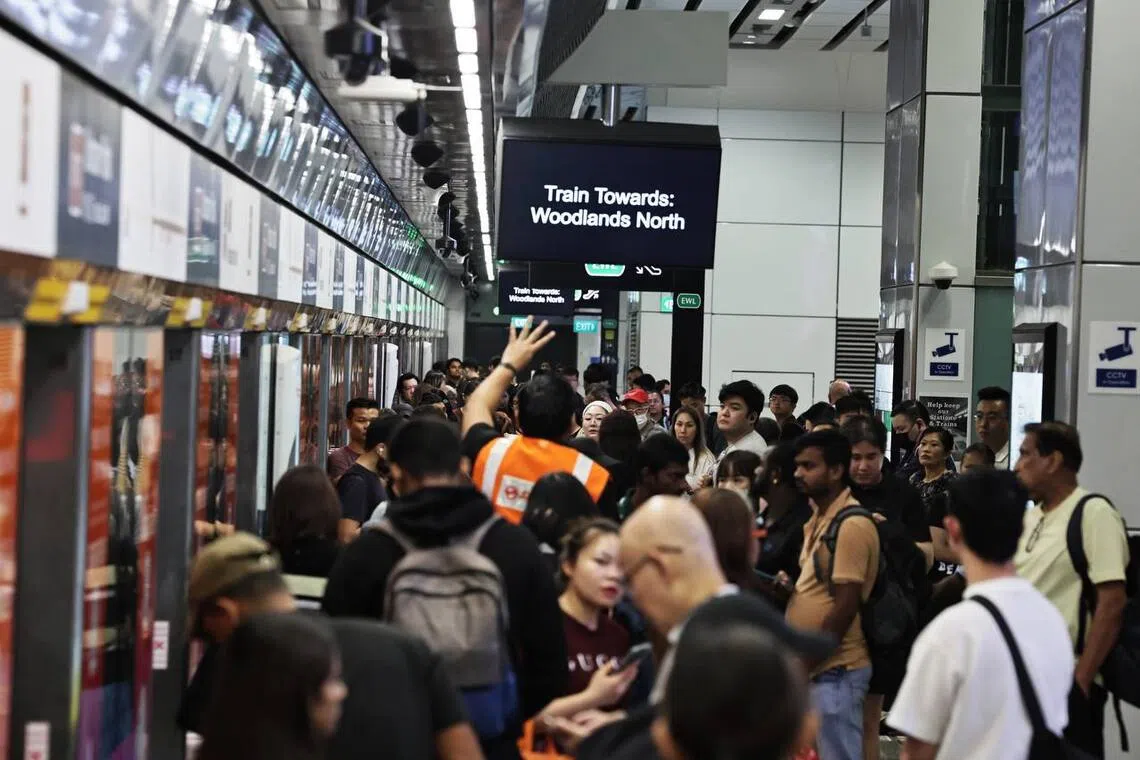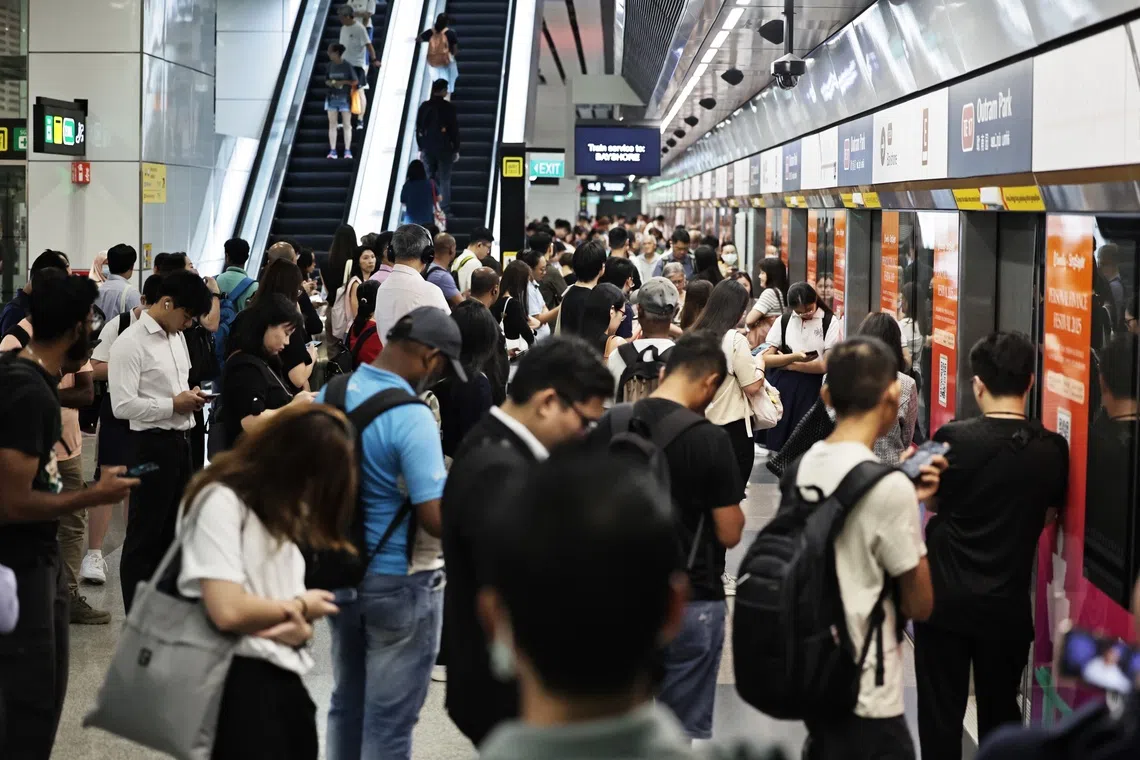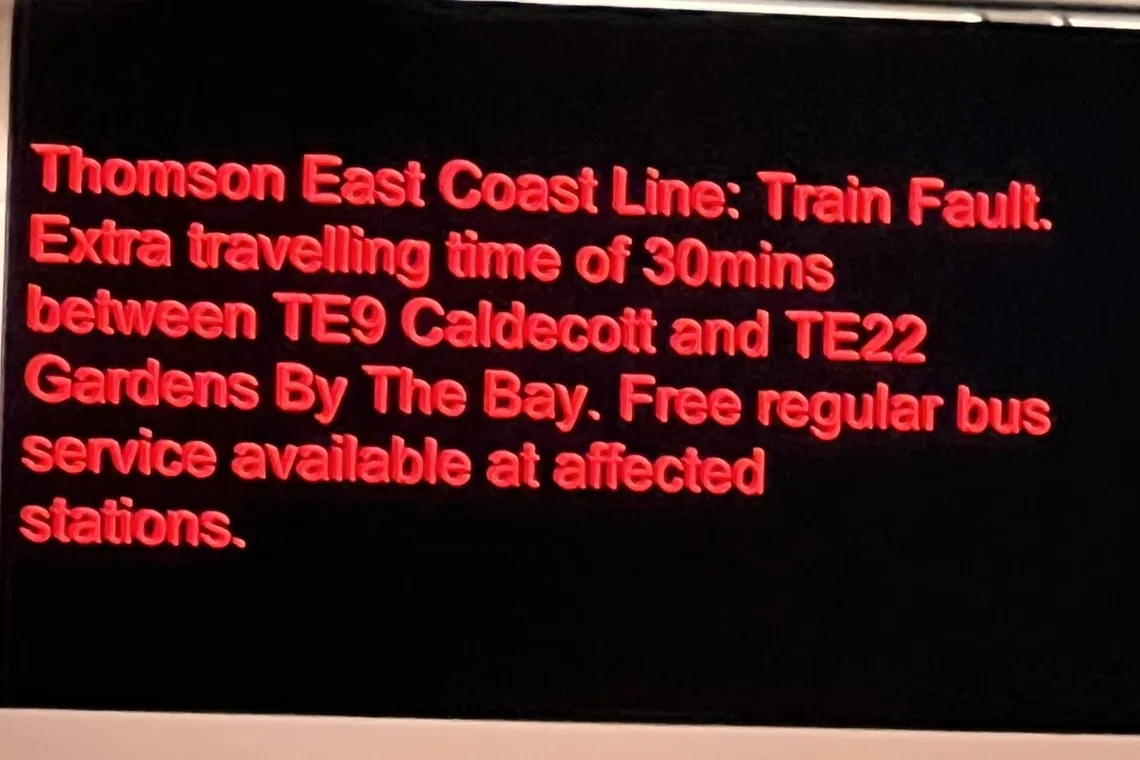LTA forms new task force with rail operators to tackle MRT, LRT disruptions
SMRT staff directing the public at Outram Park MRT station during the disruption of train service on the Thomson-East Coast Line on Sept 17.
Summary
- A task force will be formed by LTA, SMRT and SBS Transit to improve rail reliability after at least 15 recent disruptions, and it will submit recommendations by end-2025.
- The task force will review the maintenance and operation of critical systems as well as decision-making during disruptions, focusing on upgrades and faster service recovery.
- Acting Transport Minister Jeffrey Siow has asked LTA to share more information with the public on the authority’s ongoing investigations into the recent disruptions.
AI generated
Sep 19, 2025
SINGAPORE - A new task force comprising industry experts and senior leaders from the Land Transport Authority (LTA) and rail operators SMRT and SBS Transit will be formed to find immediate solutions to improve rail reliability and responses to service disruptions.
This comes after at least 15 instances of delays and interruptions across the MRT and LRT networks over the past three months, with the latest involving
the suspension of train service on the Thomson-East Coast Line during the morning peak on Sept 17.
The new task force will report its findings regularly to Acting Transport Minister Jeffrey Siow and submit its final recommendations by the end of 2025, said LTA, SMRT and SBS Transit in a joint statement on Sept 19.
It will be chaired by LTA chief executive Ng Lang and include SMRT group chief executive Ngien Hoon Ping, who was previously LTA chief, as well as SBS Transit group chief executive Jeffrey Sim. LTA did not disclose which industry experts will be roped in.
The task force will review the recent service disruptions to identify components that may require replacement, upgrading or increased maintenance.
One area that will be looked at is whether the renewal programme for the North East Line (NEL) power system can be brought forward. No timeline was given.
The NEL and Sengkang-Punggol LRT system
suffered a major electrical outage lasting several hours on Aug 12, with LTA later pledging to work with operator SBS Transit on longer-term upgrades to the power supply.
The task force will also review ways to strengthen the signalling system for the NEL and SMRT-run Circle Line in the short term before renewal is due, which typically happens around the 30-year mark.
The 22-year-old NEL and 16-year-old Circle Line use the same signalling system supplied by French company Alstom. This system is key as it directs rail traffic, keeps trains a safe distance from each other and ensures they run according to schedule.
The task force will also jointly carry out full technical audits of the maintenance and operation of critical systems, covering areas such as maintenance processes, staff training and competency, and the condition of rail assets.
Decision-making during a disruption is another area up for review, and the task force will look into ways to lower the impact of service delays on passengers.
This includes reviewing training regimes for officers on the ground, and relooking procedures to quicken service recovery and reduce the number of instances where passengers have to alight from trains between stations.
Called “detrainment”, the scenario lengthens service recovery times as added precautions need to be taken to ensure that it is safe for passengers to walk along the tracks.
In a Facebook post on Sept 19, Mr Siow said he has asked LTA to share more information with the public on the authority’s ongoing investigations into the recent rail disruptions, as well as the steps that are being taken to address them.
“By keeping the public updated, I hope you can better understand the challenges and know that we are fully committed to keeping the network safe and reliable,” he added.
“I know commuters are frustrated when disruptions occur, especially after a period over the last few years when our rail reliability has been at a high level. Train systems are complex – many things can go wrong, even with redundancies in place,” Mr Siow wrote in his post.
This is the second time in two months that the Acting Transport Minister has responded to public outcry over rail reliability.
In early August, after a five-hour disruption on the East-West Line, Mr Siow described the slew of rail incidents then as “disappointing” and pledged to do better, though he also noted that the earlier incidents were on different lines and unrelated.
On Sept 17, SMRT Trains president Lam Sheau Kai took a similar tack when
addressing the latest string of three service disruptions that occurred over four days on different lines run by the rail operator.
“These are isolated cases, not systemic issues across the rail network,” he told reporters during a press briefing at Kim Chuan Depot.
Before this recent spate of incidents, the MRT network’s overall reliability had already
fallen to its lowest level since 2020, according to LTA’s latest statistics for the 12 months ending June 2025.
On average, MRT trains clocked 1.6 million train-km without delays that lasted more than five minutes, down from
1.98 million train-km in 2024.
This is, however, still above the Government’s target of one million train-km between delays for the rail network, which was set in 2017.
In a statement on Sept 19, National Transport Workers’ Union (NTWU) executive secretary Yeo Wan Ling said the union fully supports the establishment of the new task force, noting the collaborative efforts being made to improve the rail system.
The Punggol GRC MP added: “The NTWU... will continue to advocate strongly for the well-being of all public transport workers, ensuring that they are equipped with resources and training necessary to contribute effectively.”
Date: July 1
Line: Thomson-East Coast Line
Type: Signalling fault
Cause: A faulty computing unit in signalling equipment at Orchard station affected train service between Napier and Great World stations. The component has been replaced.
Date: July 3 and 19
Line: Bukit Panjang LRT
Type: Power fault
Cause: A malfunctioning network switch at Bangkit station led to a loss of communication to the traction power system. This caused the power supply to trip for safety reasons. The switch has been replaced.
Date: July 26
Line: Bukit Panjang LRT
Type: Power fault
Cause: The contact between a train collector shoe and a power rail was poor. The collector shoe has been realigned.
Date: Aug 6
Line: North-South Line and East-West Line
Type: Track point fault
Cause: A faulty track point, which controls the movement of trains from one track to another, caused a delay to the start of service at Jurong East and Kranji stations. The faulty cables have been replaced.
Date: Aug 12
Line: Sengkang-Punggol LRT and North East Line
Type: Power fault
Cause: A faulty voltage transformer at a substation in Sengkang Depot caused two interconnected switchboards that serve as backups to each other to trip. The voltage transformer has been replaced.
Date: Aug 15
Line: Sengkang-Punggol LRT
Type: Power fault
Cause: A faulty power cable between Farmway and Kupang stations led to a system-wide power outage. The backup power supply failed to kick in due to the damage caused by the Aug 12 incident. The faulty cable has been repaired, and all power cables have been checked.
Date: Aug 28
Line: Downtown Line
Type: Track point fault
Cause: A mechanical fault in a point machine, or a device that controls a track point, between Bukit Panjang and Cashew stations affected service to Beauty World. The fault has been rectified.
Date: Sept 1
Line: Circle Line
Type: Train fault
Cause: The insulation of a cable linked to an obstacle detector failed, causing a train to stall between Marina Bay and Bayfront stations. The cable has been replaced.
Date: Sept 2
Line: North-South Line
Type: Train fault
Cause: The signalling equipment on a train near Canberra station malfunctioned, stalling the train and affecting service from Woodlands to Yishun. A faulty connector has been replaced.
Date: Sept 13
Line: Sengkang-Punggol LRT (Punggol)
Type: Signalling fault
Cause: A faulty interface component on the signalling system limited the control of trains required for start of service. The faulty component has been replaced.
Date: Sept 14
Line: North-South Line
Type: Train fault
Cause: A train door fault caused the train to stall at Toa Payoh station, affecting service from Ang Mo Kio to Newton. The faulty train door component has been replaced.
Date: Sept 16
Line: East-West Line
Type: Signalling fault
Cause: The signalling system lost power due to a component failure in the uninterruptible power supply system – which provides backup power to facilitate rail operations during incidents – at Eunos station. This affected service between Aljunied and Tanah Merah stations. Power has been restored.
Date: Sept 17
Line: Thomson-East Coast Line
Type: Signalling fault
Cause: The central signalling servers encountered a fault. This required the servers to be rebooted. During this period, the trains were operated manually, which resulted in additional travelling time. Further investigation is ongoing.









![Members of the public still waiting on the platform area of Outram Park TEL MRT station on Sept 17, 2025. (ST Photo: Kelvin Chng)//At about 8.45 am staff alert TEL resume services at the Free shuttle services bus stop at the Outram Park TEL MRT station on Sept 17, 2025. (ST Photo Kelvin Chng)] Members of the public still waiting on the platform area of Outram Park TEL MRT station on Sept 17, 2025. (ST Photo: Kelvin Chng)//At about 8.45 am staff alert TEL resume services at the Free shuttle services bus stop at the Outram Park TEL MRT station on Sept 17, 2025. (ST Photo Kelvin Chng)]](https://cassette.sphdigital.com.sg/image/straitstimes/c1eb473685336c0ec3d35a5d3f1fa447edc99f4580f9e15f96f92b38f993db18)

